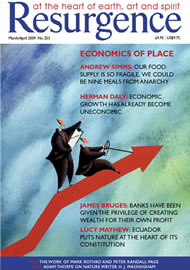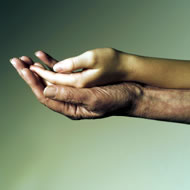WE FEEL TODAY that we are living in a world that is constantly in crisis. All around us newspapers and television warn of global warming and environmental degradation, of terrorism and international conflict, of Third World poverty and the implications of the recent economic slump. Add to this a host of other problems we encounter and things do seem to be in a mess. In the face of all this we feel a burning need for corrective action, for major interventions, government legislation, aid programmes.
We think back with an element of nostalgia to that earlier dream of a world in which we were promised accurate prediction, control and endless progress. It is only when we begin to examine in greater depth the situations we face that we realise that dream was only an illusion. The economic, social and natural systems in which we are embedded are vastly more complex than we at first imagined; certainly more complex than the organisations we have set up to deal with them. As a result, plans and interventions that were made with the best of intentions can often go awry. Aid to Africa is a case in point. While there are noted exceptions such as the International Red Cross’s successful malaria programme, other interventions have ended up disrupting local economies, societies and environments. To give just one example from many, Zambia once had 140 clothing factories; today it has only eight. The reason: exportation of donated clothing from charity shops in the West.
And so the ‘problems’ remain unresolved and when our attempts at intervention fail we just apply more of the same with even greater vigour. In this context Joseph Meeker in his book The Comedy of Survival believes we in the West have tended to view the world through the mask of tragedy. Faced with environmental problems we feel we must fight back: we declare War on Want, War on Drugs, War on Terrorism. For Meeker the solutions to the environmental problems we face must come via the route of comedy, which I see as being close to what I am calling Gentle Action.
Our conventional interventions generally take place from ‘outside’ the issue in question. By contrast Gentle Action involves something subtle and creative that emerges from within the system itself. Normal action is rather like throwing a rock into a pond. The result is a big splash that rapidly dissipates. But suppose that tiny ripples at the edge of the pond could all be arranged so as to be exactly in-phase: they would then move towards the centre, gathering in strength. In other words, a creative action would emerge out of the whole, rather than being imposed from outside.
But how does an organisation achieve sufficient sensitivity to practise Gentle Action? The answer, I believe, lies in an act of Creative Suspension. Through their mission statement and internal structures, organisations are conditioned always to take action. Creative Suspension involves a suspension and questioning of this conditioning. A lay person who arrives at the scene of a traffic accident, for example, may rush in to help by pulling a person out of a car, or tying up a bleeding arm; those actions could make a condition even more serious. The ambulance crew, by contrast, suspend immediate action by performing a triage: that is, assessing each individual, using first the eyes and then touch, in order to determine the full extent and seriousness of the injuries. Only then will they perform first aid to one, rush another to hospital, and so on.
If the desire for action is suspended then all sorts of warning signals begin to flow, and in this way the organisation becomes sensitive to its internal structure: to those areas where it is over-rigid and those others which have the potential for creativity. This is exactly what happened with the Fetzer Institute in the United States, where most programmes were suspended. Month after month staff would arrive at work each day in order to question the role and meaning of the organisation. Some became frightened and frustrated. Others began to question their place in the organisation. In this way Fetzer entered the ‘dark night of the soul’. Yet the end result was a rediscovery of the Institute’s core values and the realisation that everyone, from the president to the catering and grounds staff, had a deep sense of caring. For the president, Tom Beech, creative suspension was like that “little silence” which occurs when a person stops talking and begins to listen.
And examples of Gentle Action? They range from the global to the individual. Dan West, an American farmer, was giving out powdered milk to victims of the Spanish Civil War when he realised it would make more sense to give them a cow. And so he asked his friends back in the States to donate pregnant heifers. Today Heifer International donates twenty-five different types of animal all over the world.
In 1961 Peter Benson was distressed to read that two students had been jailed in Portugal for toasting liberty. But rather than rushing to protest outside the Portuguese embassy, he suspended action by sitting in silence in St Martin-in-the-Fields church. He then decided to write an article for The Observer newspaper in which he proposed an “Appeal for Amnesty 1961”. And so Amnesty International was born, a movement in which, simply by writing a letter, ordinary people have been able to gain the freedom of political prisoners all over the world. Other examples on the large scale would be Gandhi’s principle of ahimsa and Desmond Tutu’s ubuntu, Muhammad Yunus’s Grameen Bank, the town of Gaviotas in Columbia and Paolo Freire’s literacy movement.
I LIVE IN the medieval hilltop village of Pari, south of Siena. It is a place where people greet each other by name, stop and chat and leave their keys in the front door. Two of our visitors, Gordon Shippey and his wife, were deeply struck by life in the village and contrasted it to their own home in an area of Middleton that was filled with crime, drug dealing, garbage and burnt-out cars. When he returned home, inspired by what he had seen in Pari, he decided to walk down his street, knock on each door and introduce himself: “My name is Gordon. I’m your neighbour.” Part- way down the street he was joined by another neighbour and it soon became apparent that everyone shared the same distress about the conditions in which they lived. And so TAMS, a local association, was formed, which approached the mayor by showing him a video of the area and children’s drawings about how they saw their neighbourhood.
The result was to board up the factory where drug deals had been taking place and eventually turn it into a community centre, and street parties were organised. The spirit of TAMS spread out as other community groups formed, as well as a community newspaper, The Streetwise Insider. This led to the conversion of a former church into a large resource centre as well as a computer center for dyslexia support and groups that work with people with learning disabilities.
I have come across many other examples of individuals who have brought about a gentle change. Pauline McCormick tries to make people smile on the Underground; Jane Tinsley decorated a stone bus shelter near her home; Helena Bongartz projects art work at night onto a deserted building next to a road in the Mojave Desert.
I’d certainly like to hear of other examples of Gentle Action or Creative Suspension: please send them to [email protected]. There is additional material at www.gentleaction.org •








